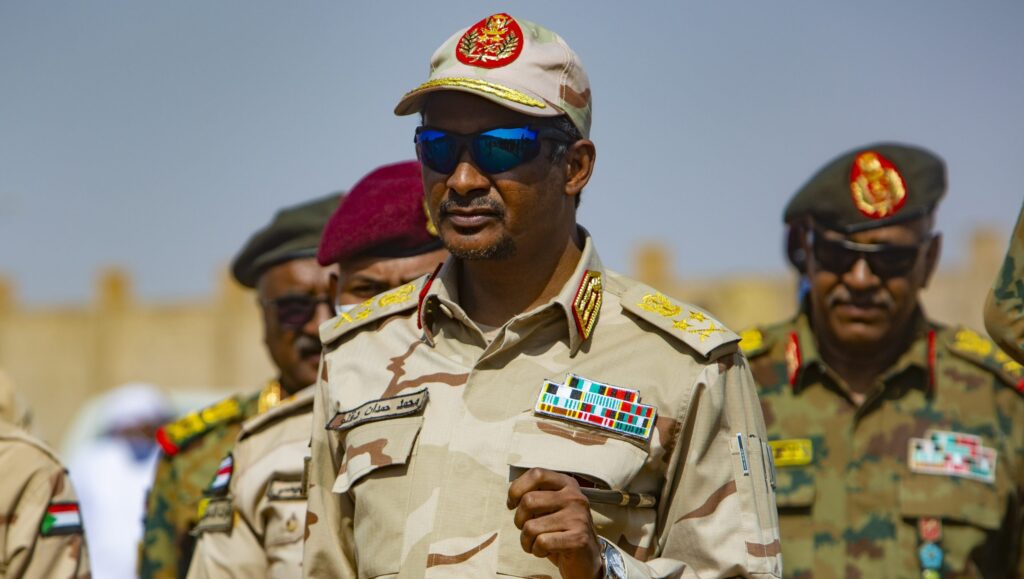Hemedti’s Ascension: A New Era for Governance in South Darfur
On August 30, 2025, Mohammed Hamdan Dagalo, commonly known as Hemedti, was inaugurated as the head of a parallel government in Nyala, South Darfur. This pivotal event signifies a shift from military authority to a form of territorial governance. The implications of this transformation are profound, highlighting a complex blend of performative governance and coercive rule.
The Nature of Statehood: Performative vs. Coercive Elements
The establishment of administrative structures—including councils and ministries—is critical for creating a sense of stability among local populations, rival factions, and international stakeholders. The dynamics observed in Sudan invite comparisons to the Libyan context. Khalifa Haftar’s control over eastern Libya serves as an instructive example: he turned military dominance into a semi-autonomous region supported by external military and political patrons, thereby creating a resilient rival administration.
Resource Control as a Foundation of Power
For Hemedti’s governance to endure, two primary elements are essential: access to resource rents and external support. In Sudan, dominance over gold-rich regions—such as those around Jebel Amer—has become a key revenue stream for the Rapid Support Forces (RSF). These revenues are funneled through local taxation and cross-border networks, converting gold into hard currency that supports military salaries and patronage networks. Simultaneously, the administration leverages these financial resources to enhance its governance capabilities.
Regional Parallels and Lessons from Libya
The post-2011 Libyan scenario illustrates how resource acquisition and foreign backing can solidify competing administrations. Oil wealth sustains rival governments while external patrons maintain their influence. Consequently, the prospect of formal peace becomes politically taxing for those benefiting from the current status quo. This preference for de facto sovereignty over reintegration is rooted in the sustained political power and income it generates.
Since 2019, Sudan’s trajectory has echoed these trends but on a much larger scale. The ongoing conflict, escalating into open warfare by 2023, has caused humanitarian crises and displacement levels that dwarf Libya’s most turbulent years, with an estimated 12 million people displaced by mid-2025. The larger population, diverse ethnic landscape, and extensive borders with multiple unstable nations will likely exacerbate the crisis through refugee flows, arms trafficking, and extremist recruitment.
External Involvement and Military Dynamics
The increasingly transactional nature of external involvement is clear. Sudan’s military has accused factions aligned with Libya’s Haftar of orchestrating border attacks with the RSF. This illustrates the intersecting dynamics of interstate patronage, foreign militias, and internal warfare, complicating domestic political negotiations and introducing external actors into the conflict.
Future Scenarios: A Spectrum of Outcomes
Potential scenarios for Sudan can be framed along three paths:
-
Worst-Case Scenario: Rigid partition solidifies rival polities, foreign support deepens, and stateless zones become havens for armed groups.
-
Intermediate Scenario: A frozen impasse where frontlines stabilize into enduring entities that perpetuate economic disparities and humanitarian crises.
-
Best-Case Scenario: Coordinated pressure reduces the profitability of militarized rule, thereby opening political space for civilian actors.
Strategies for Changing Incentives
Targeting key economic linchpins is essential for altering the current incentives. Research highlights that much of the RSF’s revenue derives from gold extraction. Disrupting networks that convert this gold into foreign currency can reduce the RSF’s operational capacity and increase the political costs associated with protracted conflict.
Implementing diplomatic denial can also exacerbate the impact of financial interventions. By refusing recognition, states restrict access to international banking and trade systems—critical elements of statehood. The United States’ recent sanctions on RSF leadership illustrate how such actions can limit financial reach and mobility.
The Importance of Regional Coordination
Effective regional coordination can act as a multiplier in addressing the crisis. When major import markets and adjacent states align their enforcement measures—such as heightened scrutiny and port controls—the liquidity available to armed groups diminishes. This can enhance the likelihood of negotiated settlements.
The case of Libya teaches that disjointed external engagement can entrench divisions rather than resolve them. A politically viable approach would integrate:
- Public denial of diplomatic recognition for entities lacking legitimacy.
- Targeted measures against financial channels that facilitate illicit revenue streams.
- Coordinated pressure on external patrons supplying logistics and arms.
- Expanded humanitarian access and local governance support, providing communities with alternatives to armed patronage.
Conclusion: A Critical Inflection Point for Sudan
Hemedti’s administration in Nyala epitomizes a crucial shift—the transition from militia control to a governance structure that mimics state functions reliant on extractive revenue and foreign backing. History warns us that such entities can be challenging to dismantle once entrenched. Given Sudan’s scale and regional complexities, the risk of widespread destabilization across the Sahel and Horn of Africa remains high if left unaddressed.
Effective strategies rooted in synchronized actions that disrupt the financial underpinnings of armed groups and uphold civilian welfare are crucial. If not effectively managed, Sudan risks normalizing a political landscape characterized not by failed states but by enduring, revenue-driven fiefdoms sustained through ongoing conflict.
For more insights on these developments, you can explore resources on Sudanese governance, military dynamics in Libya, and the humanitarian crisis in the Sahel.
